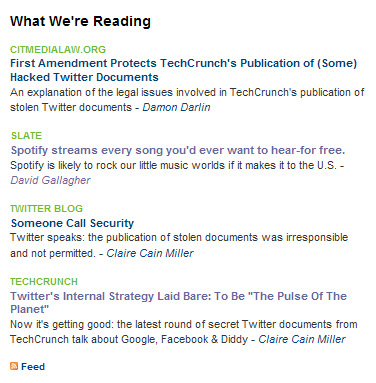New York Times Starts a “What We're Reading” Section

The New York Times recently started a "What We're Reading" feature in their Technology section. In "What We're Reading, a group of technology columnists publish links to interesting articles they find online -- from any site on the web, not just the New York Times.
A couple of weeks ago I also started a "What I'm Reading" section on my blog, which feeds into the more collective Writer River, a group link blog. While collective link sharing is nothing new, it's an important way to sift through the millions of new posts each week on the web.
As I wrote in "I need your human-aggregated content," the only way we sort through the explosion of information is with human aggregation, meaning, people tag content worth reading and share it with others. The more people who sift through information and share the worthwhile articles, the more valuable online reading becomes -- because you can quickly find interesting, engaging material, rather than sorting through everything yourself.
Publish2 is the technology behind the collaborative link sharing tool used by the New York Times. Apparently it's a collaborative journalist tool, not a tool that non-journalists can use (at least from what I understand). It's too bad, because it would make a great replacement for Writer River.
One day I imagine there will be hundreds of tech comm readers using a tool like Publish2, marking and briefly commenting on articles they recommend. And in the sidebar of nearly every tech comm blog, you'll see a syndicated stream of the collective "What We're Reading" articles (similar to the Writer River SpringWidget).
With this model, a few good posts will quickly gain visibility. People will easily find them in the sea of information because the articles will float to the top. And when people realize the web has an abundance of engaging, niche content they can easily find online, web publishing will grow even stronger because authors will see it as a viable, respectable medium for their writing endeavors.
Best Practices for Link Sharing
Publish2 has a post describing six best practices with link sharing. Best practice #2 seems especially important: "Comment to explain why the link is worth clicking." Publish2 writes,
Next to search, the greatest driver of traffic on the web is social recommendations, i.e. person-to-person recommendations. TechCrunch, for example, now gets nearly 10% of its traffic from Twitter, which is simply people recommending links to each other.
When people recommend something to each other, they typically say something about what they are recommending. This distinguishes personal recommendations from machine recommendations — algorithms can automatically pull the lede, but they can't tell you what they think or highlight what's interesting about a story.
In other words, links with personal recommendations carry far more weight than machine-generated links that simply match keywords. Adding a recommendation gives readers more motivation to check out the article.
More than just a best practice, adding recommendations and analyses about articles you read is fun. It's fulfilling. I often don't have the energy to write an entire post about something I read, just a short recommendation. Commenting also gives you a nice way of briefly analyzing the post, rather than just tagging it and moving on.
First Steps to Take
If you want to help promote the idea of a tech comm "What We're Reading," which truly aggregates the best content about technical communication on the web, do two things:
- Add the "What We're Reading" SpringWidget that appears below the ads on my sidebar to your blog's sidebar. (Click the Get this widget link below it for the code.)
- Send me the RSS feed to your recommended reads category or site, and I'll add it to the other RSS feeds flowing into the Writer River pipe.
About Tom Johnson

I'm an API technical writer based in the Seattle area. On this blog, I write about topics related to technical writing and communication — such as software documentation, API documentation, AI, information architecture, content strategy, writing processes, plain language, tech comm careers, and more. Check out my API documentation course if you're looking for more info about documenting APIs. Or see my posts on AI and AI course section for more on the latest in AI and tech comm.
If you're a technical writer and want to keep on top of the latest trends in the tech comm, be sure to subscribe to email updates below. You can also learn more about me or contact me. Finally, note that the opinions I express on my blog are my own points of view, not that of my employer.

